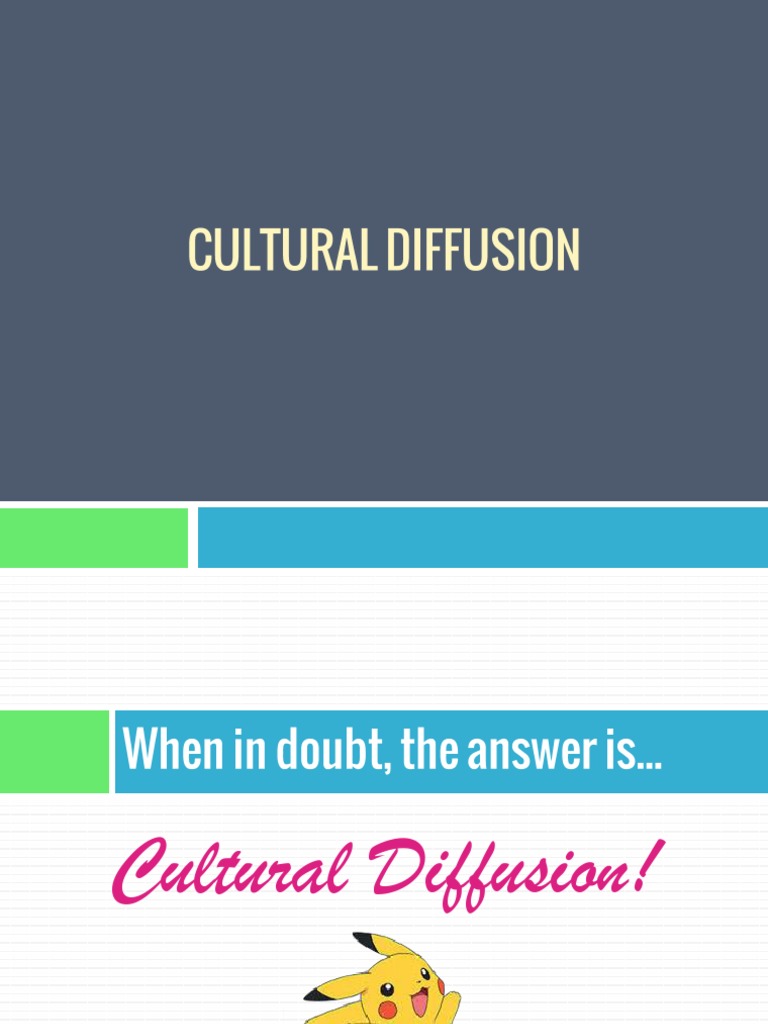Cultural diffusion, a fundamental concept in world history, encapsulates the process through which cultural beliefs, practices, technologies, and artifacts spread from one society or social group to another. This phenomenon is not merely a historical artifact but a dynamic process that continues to shape contemporary societies. By understanding cultural diffusion, we gain insight into the interconnectedness of civilizations throughout history and the myriad ways in which human cultures evolve.
To grasp the significance of cultural diffusion, one must first comprehend its mechanisms. It occurs through various channels, including trade, migration, conquest, and even the exchange of ideas facilitated by technological advancements. When individuals or groups relocate, they carry their cultural goods with them, often leading to a syncretism that enriches both the originating and the receiving cultures. Additionally, trade routes have historically served as arteries for cultural exchange, allowing for the transfer of not only commodities but also philosophies, religions, and innovations.
The roots of cultural diffusion can be traced back to the earliest human societies. Hunter-gatherer groups interacted with neighboring tribes, leading to the borrowing of tools and techniques. As agricultural practices emerged, the diffusion of crops such as wheat, rice, and maize fundamentally transformed societies, impacting population growth and settlement patterns. The emergence of urban centers in Mesopotamia, the Indus Valley, and ancient China illustrates how agriculture facilitated interactions among diverse groups, giving rise to complex societies enriched by various cultural elements.
One illustrative case of cultural diffusion is the spread of the Silk Road, a network of trade routes that connected the East and West. Spanning over 4,000 miles, it facilitated not only the exchange of silk and spices but also the dissemination of ideas and practices. Buddhism, for instance, traveled from India to East Asia along these routes, undergoing adaptations that reflected local customs and beliefs. Such transformations highlight the bidirectional nature of cultural diffusion: while Buddhism influenced East Asian societies, these societies also imparted unique interpretations that contributed to the religion’s evolution.
Another notable example is the Hellenistic period following the conquests of Alexander the Great. His campaigns facilitated a confluence of Greek and Eastern cultures, leading to the establishment of urban centers that became melting pots of philosophies, arts, and sciences. Alexandria, in particular, exemplified this fusion as it became a beacon of learning and scholarship, attracting intellectuals from diverse backgrounds. The synthesis of Greek rationalism with Eastern thought processes birthed new philosophical schools, driving advancements in various fields such as mathematics and astronomy.
Cultural diffusion is also observable in the realm of language. The spread of Latin during the Roman Empire not only unified vast territories under a common administrative language but also laid the groundwork for the Romance languages that evolved from it. This diffusion of language illustrates how cultural elements can transcend geographical boundaries, establishing frameworks for communication that persist long after their initial adoption.
Moreover, the impact of the Columbian Exchange illustrates the profound effects of cultural diffusion on a global scale. Following Christopher Columbus’s voyages, the transatlantic movement of flora and fauna transformed agriculture in both the New World and the Old World. Crops such as potatoes and tomatoes became staples in various cultures, leading to population booms and shifts in dietary practices. Conversely, Old World livestock and crops affected indigenous agricultural systems, demonstrating the extensive interplay between culture and ecology.
In contemporary society, the forces of globalization exacerbate the speed and scope of cultural diffusion. The advent of the internet and social media has ushered in a new era of connectivity, allowing ideas and cultural practices to transcend borders instantaneously. The spread of pop culture, for instance, illustrates how music, fashion, and trends can diffuse rapidly across the globe, often leading to hybrid forms that blur traditional distinctions. Yet, this rapid diffusion raises essential questions about cultural appropriation and the authenticity of cultural expressions.
As we contemplate cultural diffusion, one must acknowledge its dual nature. On one hand, it fosters diversity, innovation, and understanding among different cultures; on the other, it can lead to conflicts over cultural identity and ownership. The discourse surrounding cultural appropriation in modern contexts highlights the importance of recognizing the origins and significance of cultural practices before adopting them indiscriminately. This raises ethical considerations surrounding respect, representation, and the commodification of culture in an increasingly interconnected world.
Understanding the historical and contemporary implications of cultural diffusion invites us to confront our biases and broaden our perspectives. Each interaction between cultures has the potential to enrich our understanding of humanity itself. Rather than viewing cultural diffusion as a mere process of borrowing and adapting, one can perceive it as a complex dialogue that reflects the shared experiences and aspirations of diverse peoples.
In conclusion, cultural diffusion serves as a prism through which we can scrutinize the tapestry of human history. It illuminates the threads of connection that bind us across time and space, offering a lens to understand the evolution of societies. As we navigate an increasingly globalized world, fostering a deeper awareness of cultural diffusion encourages a more harmonious coexistence, promoting empathy, respect, and a richer appreciation for the intricate mosaic of human culture.
